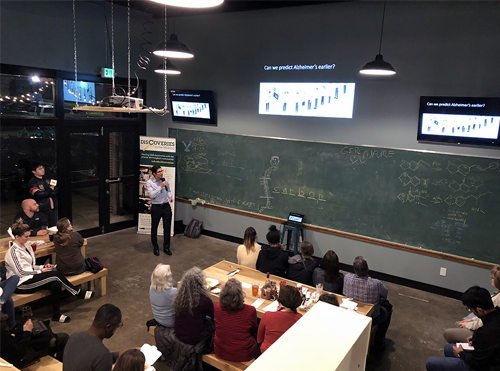Most of you would be familiar with the novel "The Notebook" by Nicholas Sparks; there is also a movie based on that story. It is about a couple and their battle with Alzheimer's. The woman falls prey to this disease, and we go on a journey of how not only the woman with the disease suffers but also all her loved ones. The woman loses all her memory, her ability to think and perform basic daily tasks. She also exhibits changes in her behavior/personality and has a lot of confusion orienting herself to what time she is in and where she is.
 Fabio Raman, an MD-PhD in the biomedical engineering department at UAB, describes how his work can contribute to help us diagnose Alzheimer's disease much early on in life. His work may ultimately help us to develop a treatment against Alzheimer's.
Fabio Raman, an MD-PhD in the biomedical engineering department at UAB, describes how his work can contribute to help us diagnose Alzheimer's disease much early on in life. His work may ultimately help us to develop a treatment against Alzheimer's.
What is Alzheimer's disease and its prevalence?
Alzheimer's is a type of dementia that causes problems with memory, thinking and behavior. Symptoms usually develop slowly and get worse over time, becoming severe enough to interfere with daily tasks. It is the primary cause of age-related dementia, affecting nearly 50 million people worldwide in 2017. The global cost for care exceeded $818 billion in 2015. This amount was 35 percent higher than that from 2010 and is second only to cancer care in terms of direct societal costs.
Signs and Symptoms observed in Alzheimer's
Alzheimer's disease has stages of signs and symptoms as it progresses. Unfortunately, we currently only have clinical methods to test the late stage symptoms of the disease. Raman tells us that the first clinical sign occurs at the level of a single neuron in the brain. This sign is amyloid beta plaques (hard, insoluble plaques that collect in the cells), this happens almost 15- 20 years before the onset of the disease symptoms. Then form the tau tangles (collapsed microtubules that initially were used to transport nutrients), this occurs 10-15 years before the disease. Then the structural changes happen in the brain, and lastly, we see cognitive changes. These cognitive changes are our current standard methods to test for the diagnosis of the disease.
 So how can an early diagnosis be possible?
So how can an early diagnosis be possible?
Raman is working to develop an algorithm named BLAzER (Biomarker Localization, analysis, Visualization, Extraction, and Registration). This algorithm will help to detect the disease when it forms amyloid beta plaques and tau tangles (early stages). BLAzER segments an MRI scan (helps to understand the structural integrity of the tissue) to generate a 3D brain map of the patient. It then combines this brain map with a PET scan (shows us the quantity and position of a particular biomarker). This combined map then provides us with the ability to extract regional PET measurements and quantify results. These regional measurements can then help us assess the progression of the disease in different parts of the brain.
How will this work help the people?
Using BLAzER algorithm and widely used technologies of MRI and PET scan, one can process the information quickly and easily. Doctors across the world will be able to help better diagnose their patients earlier. BLAzER will help us tell the patient how far they have progressed along the disease or even if they have the disease or not much before they show any clinical symptoms. This technology may also provide us with the ability to discover new treatments that patients can use before the onset of clinical symptoms. BLAzER can save us billions of dollars every year and improve the life of Alzheimer's patients and their loved ones drastically.
 Into the future...
Into the future...
Raman intends to create a massive database of PET scan and MRI scan images of the disease so that an artificial intelligence system can one day analyze the patient data in real time. An actual comparison of the patient's current photos to the database of thousands of other patients who have had the disease will allow us to answer questions like where along the spectrum of the illness a particular patient is and how long before they show cognitive impairments. Thus, it may be possible in the future to recommend this test to everyone at a certain age to ascertain whether or not they have the risk of developing the disease and possibly even treat the disease or slow its progression before the condition begins.